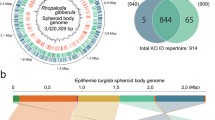Abstract
Members of the diatom family Rhopalodiaceae possess cyanobacteria-derived intracellular structures called spheroid bodies (SBs) that very likely carry out nitrogen fixation. Due to the shortage of molecular data from SBs and rhopalodiacean diatoms, it remains unclear how SBs were established and spread in rhopalodiacean diatoms. We here amplified the small subunit ribosomal DNA sequences from both host and SB in three rhopalodiacean diatom species, Epithemia turgida, E. sorex, and Rhopalodia gibba. Phylogenetic analyses considering these new sequences clearly indicate that the SBs were acquired by a common ancestor of rhopalodiacean diatoms and have been retained during host speciation.


Similar content being viewed by others
References
Capone DG, Zehr JP, Paerl HW, Bergman B, Carpenter EJ (1997) Trichodesmium, a globally significant marine cyanobacterium. Science 276:1221–1229
Carpenter EJ, Janson S (2000) Intracellular cyanobacterial symbionts in the marine diatom Climacodium frauenfeldianum (Bacillariophyceae). J Phycol 36:540–544
DeYoe HR, Lowe RL, Marks JC (1992) Effects of nitrogen and phosphorus on the endosymbiont load of Rhopalodia gibba and Epithemia turgida (Bacillariophyceae). J Phycol 28:773–777
Drum RW, Pankratz S (1965) Fine structure of an unusual cytoplasmic inclusion in the diatom genus, Rhopalodia. Protoplasma 60:141–149
Geitler L (1977) Zur Entwicklungsgeschichte der Epithemiaceen Epithemia, Rhopalodia und Denticula (Diatomophyceae) und ihre vermutlich symbiontischen Sphäroidkörper. Plant Syst Evol 128:259–275
Hajos M (1986) Stratigraphy of Hungary’s Miocene diatomaceous earth deposits. Geologica Hungarica Series Palaeontologica 49:1–339
Huelsenbeck JP, Ronquist F (2001) MRBAYES: Bayesian inference of phylogenetic trees. Bioinformatics 17:754–755
Janson S, Rai AN, Bergman B (1995) Intracellular cyanobiont Richelia intracellularis: ultrastructure and immuno-localization of phycoerythrin, nitrogenase, Rubisco and glutamine synthetase. Mar Biol 124:1–8
Kies L (1992) Glaucocystophyceae and other protists harbouring prokaryotic endocytobionts. In: Reisser W (ed) Algae and symbioses. Biopress, Bristol, pp 353–377
Kneip C, Lockhart P, Voss C, Maier UG (2007) Nitrogen fixation in eukaryotes—new models for symbiosis. BMC Evol Biol 7:55
Kneip C, Voss C, Lockhart PJ, Maier UG (2008) The cyanobacterial endosymbiont of the unicellular algae Rhopalodia gibba shows reductive genome evolution. BMC Evol Biol 8:30
Nakayama T, Ishida K (2009) Another acquisition of a primary photosynthetic organelle is underway in Paulinella chromatophora. Curr Biol 19:R284–R285
Nakayama T, Marin B, Kranz HD, Surek B, Huss VAR, Inouye I, Melkonian M (1998) The basal position of scaly green flagellates among the green algae (Chlorophyta) is revealed by analyses of nuclear-encoded SSU rRNA sequences. Protist 149:367–380
Prechtl J, Kneip C, Lockhart P, Wenderoth K, Maier UG (2004) Intracellular spheroid bodies of Rhopalodia gibba have nitrogen-fixing apparatus of cyanobacterial origin. Mol Biol Evol 21:1477–1481
Round FE, Crawford RM, Mann DG (1990) The diatoms. Cambridge University Press, Cambridge
Simonsen R (1979) The diatom system: ideas on phylogeny. Bacillaria 2:9–71
Sims PA, Mann DG, Medlin LK (2006) Evolution of the diatoms: insights from fossil, biological and molecular data. Phycologia 45:361–402
Stamatakis A (2006) RAxML-VI-HPC: maximum likelihood-based phylogenetic analyses with thousands of taxa and mixed models. Bioinformatics 22:2688–2690
Yoon HS, Nakayama T, Reyes-Prieto A, Andersen RA, Boo SM, Ishida K, Bhattacharya D (2009) A single origin of the photosynthetic organelle in different Paulinella lineages. BMC Evol Biol 9:98
Zehr JP, Waterbury JB, Turner PJ, Montoya JP, Omoregie E, Steward GF, Hansen A, Karl DM (2001) Unicellular cyanobacteria fix N2 in the subtropical North Pacific Ocean. Nature 412:635–638
Acknowledgments
We would like to thank Haruka Kogure and Yoshihisa Hirakawa (University of Tsukuba) for kindly providing a sample of Saiko and valuable help with laboratory works, respectively. Takuro Nakayama is supported by a JSPS Research Fellowship for Young Scientists (DC1). YI is supported by a grant from JSPS (no. 21370031).
Author information
Authors and Affiliations
Corresponding author
Additional information
Takuro Nakayama and Y. Ikegami contributed equally to this study.
Electronic supplementary material
Below is the link to the electronic supplementary material.
Rights and permissions
About this article
Cite this article
Nakayama, T., Ikegami, Y., Nakayama, T. et al. Spheroid bodies in rhopalodiacean diatoms were derived from a single endosymbiotic cyanobacterium. J Plant Res 124, 93–97 (2011). https://doi.org/10.1007/s10265-010-0355-0
Received:
Accepted:
Published:
Issue Date:
DOI: https://doi.org/10.1007/s10265-010-0355-0




